Hyundai Accent: Brake System / Rear Disc Brake
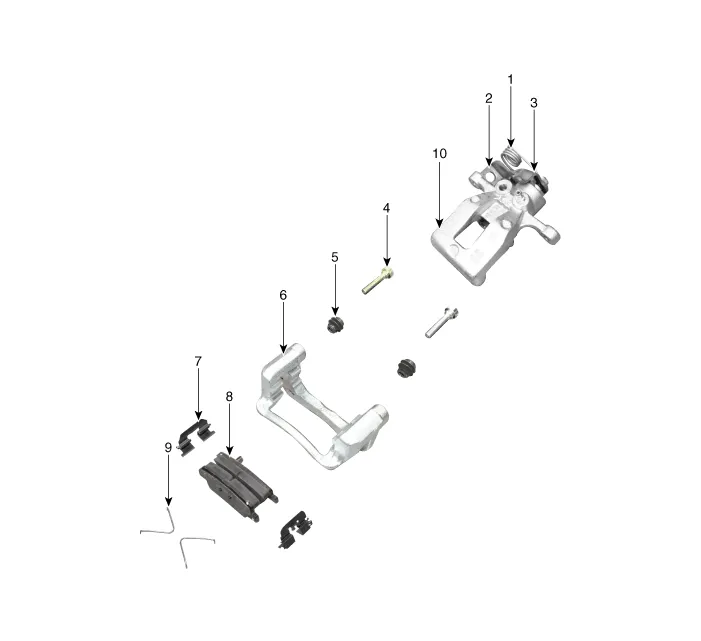
1. Return spring
2. Operating lever
3. Stopper
4. Guide rod pin
5. Guide rod boot
6. Caliper carrier
7. Pad retainer
8. Brake pad
9. Pad return spring
10.Caliper body
1.Loosen the wheel nuts slightly.Raise the vehicle, and make sure it is securely supported.
2.Remove the rear wheel and tire (A) from front hub.
Tightening torque :107.9 - 127.5 N.m (11.0 - 13.0 kgf.m, 79.6 - 94.0 lb-ft)
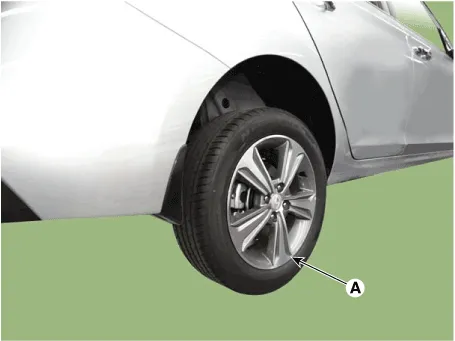

• Be careful not to damage the hub bolts when removing the rear wheel and tire.
3.Disconnect the brake tube by loosening the tube flare nut (A).
Tightening torque :12.7 - 16.7 N.m (1.3 - 1.7 kgf.m, 9.4 - 12.3 lb-ft)
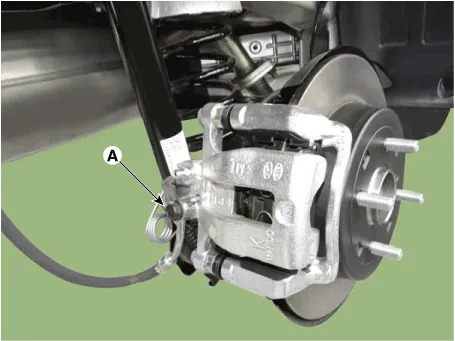
4.Loosen the guide rod bolt and then remove the caliper body.
Tightening torque :21.6 - 31.4 N.m (2.2 - 3.2 kgf.m, 15.9 - 23.1 lb-ft)
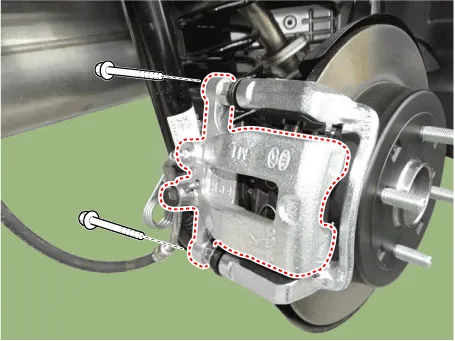
5.Remove the pad return spring (A).
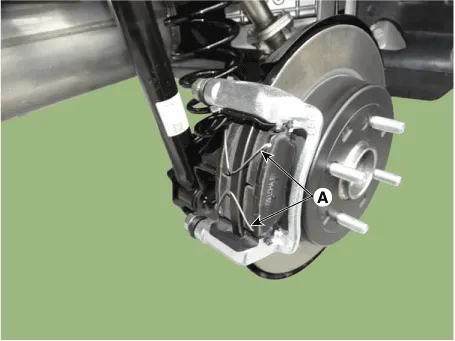

• Pad return springs must be replaced with new ones whenever pads are replaced.
• Technicians should be careful not to deform pad return springs.
• When pad return springs are deformed, it may cause improper braking, more fuel consumption.
6.Remove the brake pad.
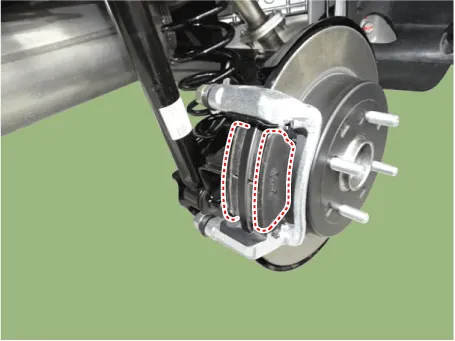
7.Remove the brake pad (A).
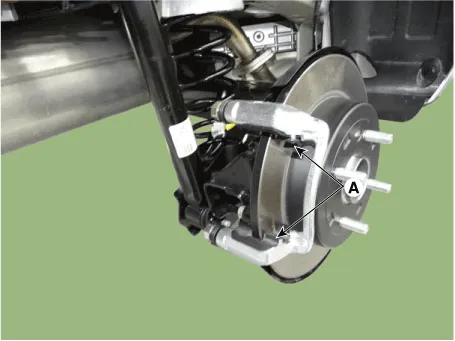
8.Loosen the caliper mounting bolts and then remove the rear caliper assembly.
Tightening torque :63.7 - 73.5 N.m (6.5 - 7.5 kgf.m, 47.0 - 54.2 lb-ft)
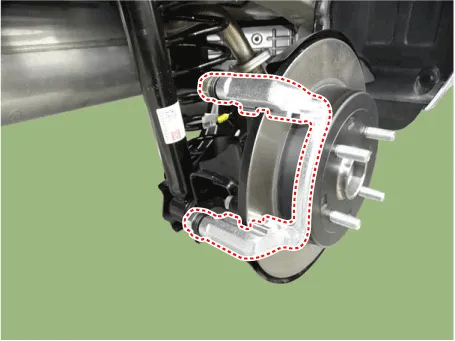
9.Loosen the screws and then remove the brake disc.
Tightening torque :4.9 - 5.9 N.m (0.5 - 0.6 kgf.m, 3.6 - 4.3 lb-ft)
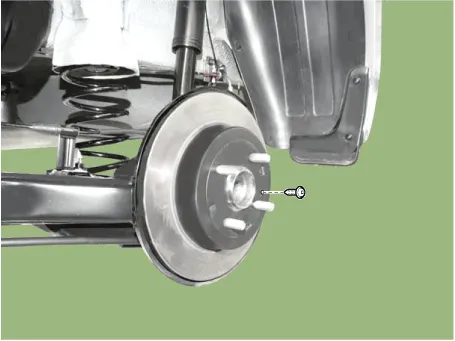
1.Loosen the wheel nuts slightly.Raise the vehicle, and make sure it is securely supported.
2.Remove the rear wheel and tire (A) from front hub.
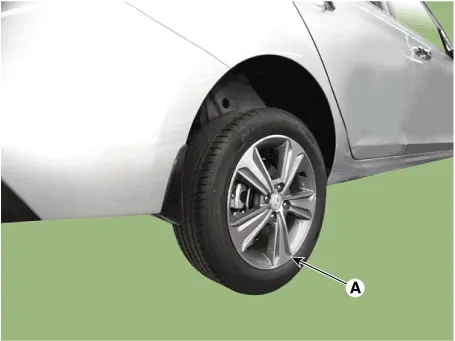

• Be careful not to damage the hub bolts when removing the rear wheel and tire.
3.Remove the parking brake cable fixed clip (A).
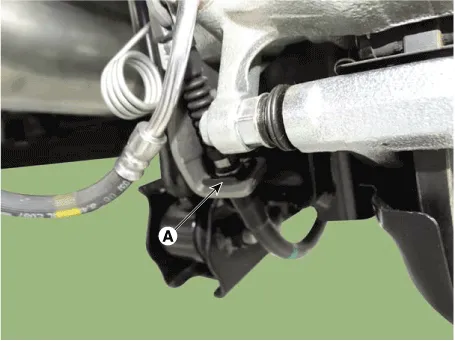
4.Pull the operation lever as a arrow below in order to loosen the cable and then remove the parking cable.
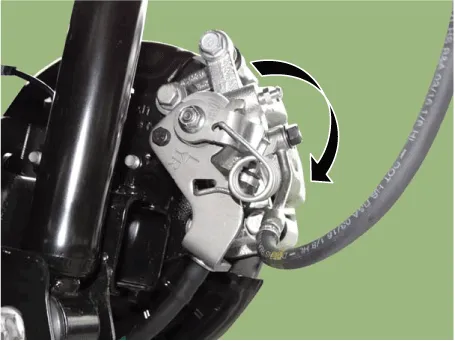
5.Loosen the guide rod bolt (B) and then down the caliper body.
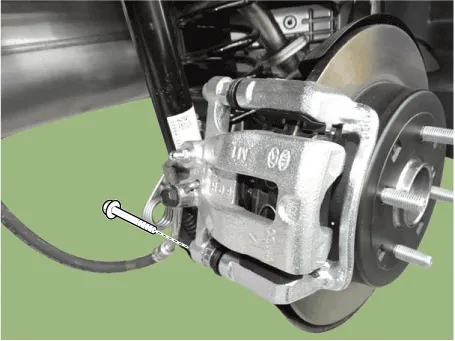
6.Remove the pad return spring (A).
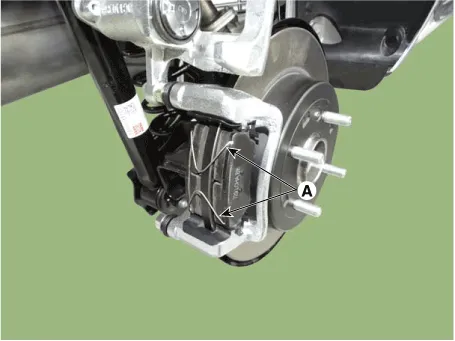
7.Remove the brake pad.
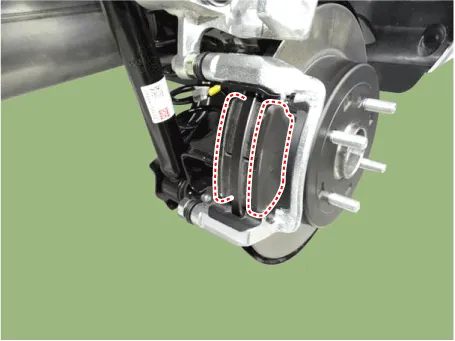
8.Remove the brake pad retainer (A).
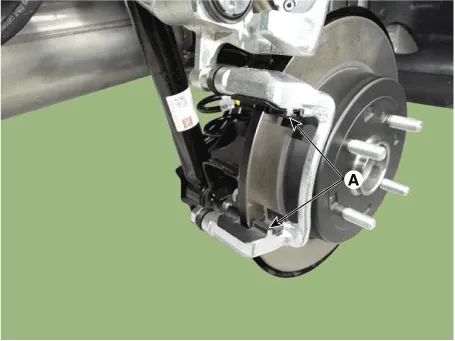
9.Repalce the brake pad and retainer.
10.Install the pad return spring (A).
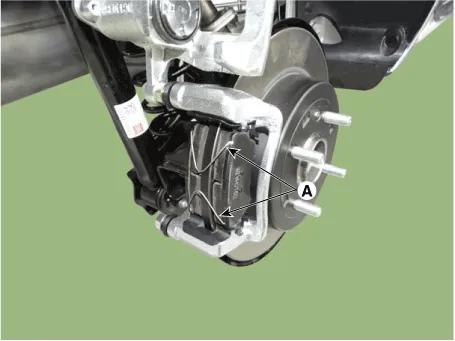

• Pad return springs must be replaced with new ones whenever pads are replaced.
• Technicians should be careful not to deform pad return springs.
• When pad return springs are deformed, it may cause improper braking, more fuel consumption.
11.Use a SST (09580-0U000) when installing the brake caliper assembly.
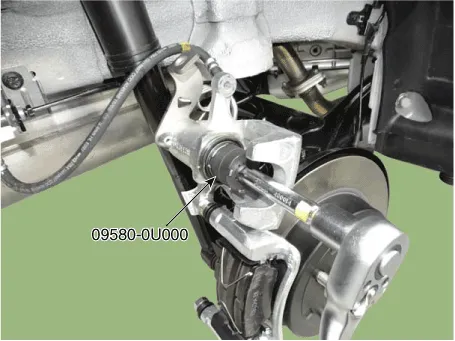
12.Install the caliper body.
Tightening torque :21.6 - 31.4 N.m (2.2 - 3.2 kgf.m, 15.9 - 23.1 lb-ft)
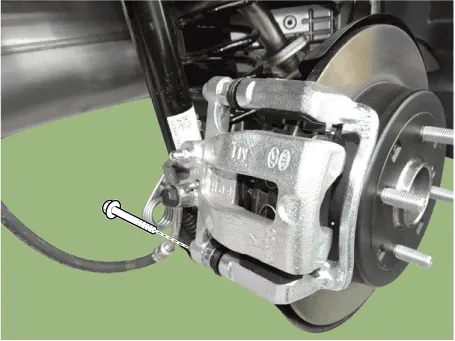
13.Install the parking brake cable.
14.Install the rear wheel and tire (A).
Tightening torque :107.9 - 127.5 N.m (11.0 - 13.0 kgf.m, 79.6 - 94.0 lb-ft)
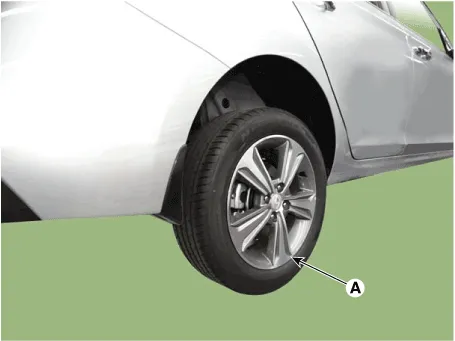

• Be careful not to damage the hub bolts when installing the rear wheel and tire.
1.Loosen the wheel nuts slightly.Raise the vehicle, and make sure it is securely supported.
2.Remove the rear wheel and tire (A) from front hub.
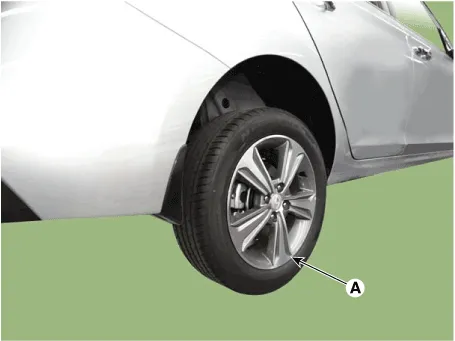

• Be careful not to damage the hub bolts when removing the rear wheel and tire.
3.Loosen the guide rod bolt and then remove the caliper body.

4.Replace the guide rod (A) and boot (B).
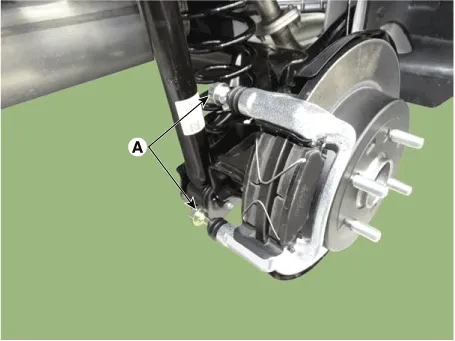
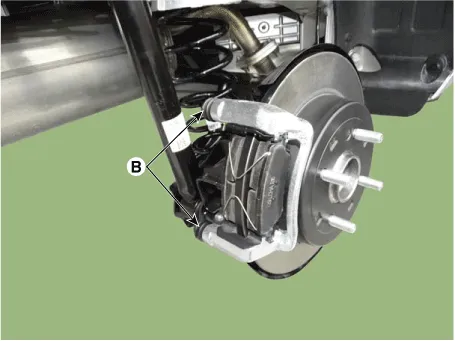

• Apply the grease on the guide rod pin.Grease type : GREASE BG-1 (MG511-60)Capacity : 0.35 - 0.8 g
• If apply the grease excessively, would not be assembled the guide rod pin.
5.Install the caliper body.
Tightening torque :21.6 - 31.4 N.m (2.2 - 3.2 kgf.m, 15.9 - 23.1 lb-ft)
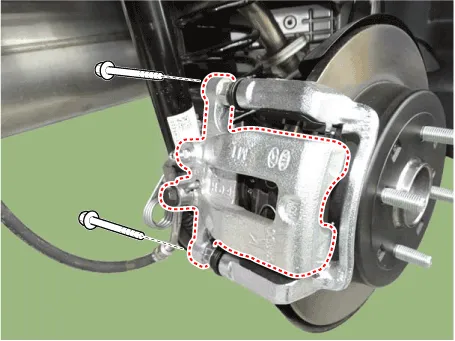
6.Install the rear wheel and tire (A).
Tightening torque :107.9 - 127.5 N.m (11.0 - 13.0 kgf.m, 79.6 - 94.0 lb-ft)
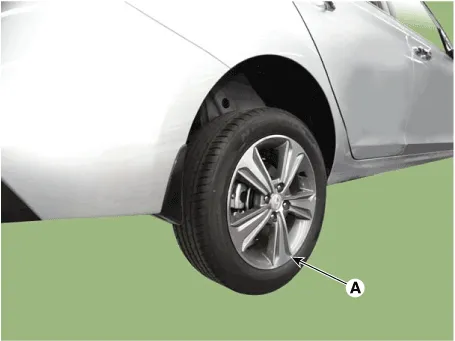

• Be careful not to damage the hub bolts when installing the rear wheel and tire.
1.Check the brake pads for wear and fade.
2.Check the brake disc for damage and cracks.
3.Remove all rust and contamination from the surface, and measure the disc thickness at 24 points, at least, of same distance (5mm) from the brake disc outer circle.
Brake disc thicknessStandard : 10 mm (0.394 in)Service limit : 8.4 mm (0.331 in)Deviation : less than 0.015 mm (0.0002 in)

4.If wear exceeds the limit, replace the discs and pad assembly left and right of the vehicle.
1.Check the pad wear. Measure the pad thickness and replace it, if it is less than the specified value.
Pad thicknessStandard value : 15 mm (0.59 in)Service limit : 7.0 mm (0.28 in)
2.Check the damage of pad, backing metal and contamination with grease.
1.Place a dial gauge about 10mm (0.2 in.) from the outer circumference of the brake disc, and measure the runout of the disc.
Brake disc runoutLimit : 0.055 mm (0.0016 in.) or less (new one)

2.If the runout of the brake disc exceeds the limit specification, replace the disc, and then measure the runout again.
3.If the runout exceeds the limit specification, install the brake disc after turning it 180° and then check the runout of the brake disc again.
4.If the runout cannot be corrected by changing the position of the brake disc, replace the brake disc.
1.To install, reverse the removal procedure.
2.Use a SST (09580-0U000) when installing the brake caliper assembly.
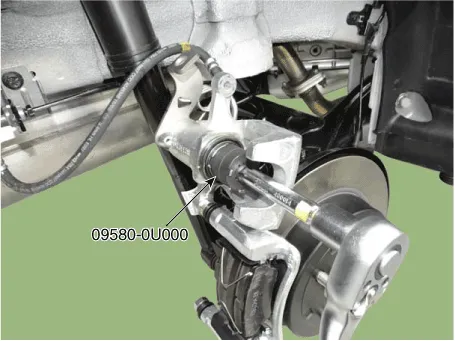

• Wind the piston into the caliper body until it is fully retracted.
• Do not use any power assisted tools for this task.
3.After installing, bleed the brake system. (Refer to Brake System - "Brake System Bleeding")(Refer to Brake System - "ABS System Bleeding")(Refer to Brake System - "ESP System Bleeding")

• Re- setting of the parking brake is necessary after overhauling the caliper body, or if the brake calipers, housing, parking brake cable or brake discs have been changed.
1.Remove the floor console to reach the adjusting nut.
2.Loosen the parking brake cable until both operating levers rest in fully off position.
3.Bring the brake pads in their operating position by pressing the brake pedal down several times until there is resistance.
4.Tension the parking brake cable by tightening the adjusting nut, until the operating levers on both calipers lift from the stop, up to a distance of (A) and (D) between operating lever (B) and stopper (C).
Distance (A + D) : Max. 3 mm (0.12 in)

5.Refit the floor console.
6.Parking brake lever in the car must be in fully loosened position.
7.If the handbrake cables where changed, actuate the parking brake a few times with maximum force to stretch the parking brake cables, and then control adjusting as above.
8.Check the wheels of their free operation.
9.Test drive.
Other information:
Hyundai Accent (HC) (2017 - 2022) Service Manual: Troubleshooting
- Trouble Symptom Charts Trouble Symptom 1 Trouble Symptom 2 Trouble symptomProbable causeRemedy The set vehicle speed varies greatly upward or downward"Surging" (repeated alternating acceleration and deceleration) occurs after settingMalfunction of the vehicle speed sensor circuitRepair the vehicle speed sensor system, or replace the part Malfunction of ECMCheck input and output signals at ECM Trouble Symptom 3 Trouble symptomProbable causeRemedy The CC system is not canceled wheHyundai Accent (HC) (2017 - 2022) Service Manual: Troubleshooting
- Troubleshooting Trouble symptomSuspect areaRemedy Clutch slipping • Car will not respond to engine speed during acceleration • Insufficient vehicle speed • Lack of power during uphill driving Insufficient pedal free playAdjust Clogged hydraulic systemCorrect or replace parts Excessive wear of clutch disc facingReplace Hardened clutch disc facing, or oil on surfaceReplace Damaged pressure plate or flywheelReplace Weak or broken pressure springReplace Diff
Categories
- Manuals Home
- Hyundai Accent Owners Manual
- Hyundai Accent Service Manual
- New on site
- Most important about car


